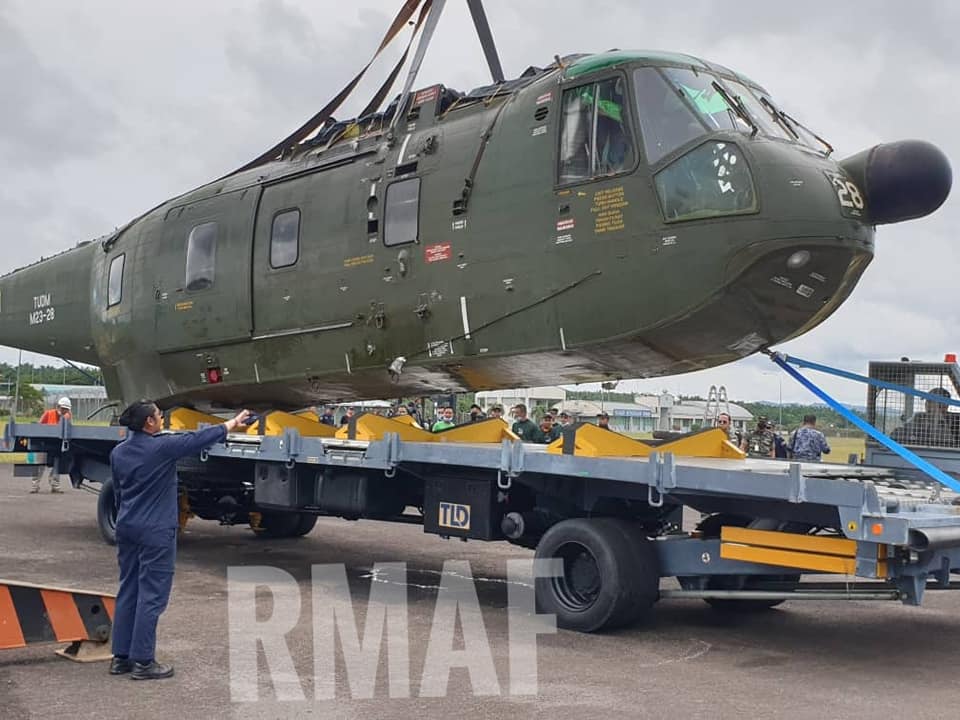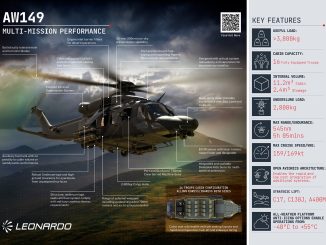
SHAH ALAM: Two Nuri helicopters – M23-02 and M23-07 – stored at the Kuching airbase following their retirement in 2019/2020 will be used a training aid for students of Centre for Technology Excellence Sarawak Sdn Bhd or CENTEX.
The technical and vocational training institute is under Yayasan Sarawak. The hand-over ceremony for the two helicopters was conducted at the airbase on September 27. NADI Sdn Bhd which is the holding company for Airod which has been the MRO provider for the helicopters for the last 30 years accepted the delivery of the helicopters on behalf of CENTEX. See the Instagram post below:

It is likely other Nuri helicopters stored at the Subang airbase will also be donated to other learning institutions as training aids for students. Donating retired airframes to learning institutions are pretty common, both RSAF and Indonesian Air Force (TNI-AU), also recently donated their retired Super Puma helicopters to TVET colleges in their respective countries.
— Malaysian Defence
If you like this post, buy me an espresso. Paypal Payment




Good. Malaysia as the 2nd best aerospace industry in ASEAN after Singapore (even this both country dont build/manufacture aircraft) need to keep their skilled workers available so our aerospace industry can soaring high.
The problem with SG is that they continue to hunt/attract our experienced workers in the aerospace industry with higher wages.
To be fair brain drain rates in SG is slightly higher then us.
Interestingly its from TUDM stock. What about PUTD ones?
I wonder what can students actually learn from ancient & obsoleted nonflying birds. How can they apply anything to current highly connected modern choppers full of electronics. Its like comparing a 1st Saga to current S70.
Rock,
Pray tell. How can the aerospace industry “soar high”? It’s afflicted with the same problems other industries have.
hopefully strengthing MYR and FA-50M assembly plant able to mitigate the supposed brain drain
And then do what with the plant, pray tell. Such scheme is just to transfer money from the defence budget to someone’s pocket.
No one trained on the latest aircraft apart from people at the OEM. Even people at Proton do not train on the latest vehicles ie S70 or X90 apart from those building or maintaining them.
Plans like assembly lines for fighters and regional MROs excite fanboys and make the politicians look good but are a colossal waste of time and taxpayers cash. We simply lackthe numbers and resources
We’ve been trying to make the aerospace sector “soar” since the 1990’s but look where we are now.
From the Hawk offset enablling SME to produce pylons, the he Hornet offset with McDonell Douglas and other he A400M offset enabling CTRM to produce ladders; decades later what tangible benefits have we gained?
Offers, MRO centres and assembly lines are fully paid for my thr taxpayer. Thank her benefit a selected few but not sure he comes but not the thecountry as a whole.
“apart from those building or maintaining them”
Exactly! Do we want students to come out armed with knowledge to build/fix modern cars or do we want them to go work at bengkel bawah pokok because they have no clue when dealing with electronics?
What kind of aviation grads do we want these students to be, ready drop into the aeronautics industry as either mechanics, technicians, engineers, since they were trained on modern platforms, they know how to use computers & diagnostic software? Or do we just want them to work on simple light planes as they werent trained on jumbos?
Alex
“hopefully strengthing MYR”
Its only temporary the last couple of weeks. What about the last months or years before GE15? Without the right strategy to truly strenghten RM it will continue to be at the mercy of stronger economics. As it stands it is only a matter of when not if, that RM will fall back again soon. Just enjoy while it last but its nothing tangible to be attractive long term.
They will be trained properly when they are gainfully employed. No training institution will spend millions on things to be dissected by their students.
@joe.. even in SG they donate only used and retired airframes, in recent case they just donated a 30+ Puma helicopter to a polytechnic. As for fixed wing , the only a/c donated to the polys are an ancient Skyhawk. Basically the students only learn fundamental principles and techniques which can be built on with the in house training in the aerospace companies or military specialists schools. As for the brain drain question which was mentioned earlier, the issue is mainly economic ( better pay/ bonuses due to company being profitable)and job prospects/ promotions etc. the pay is dollar to dollar is I believe almost the same but the strength of the S$ is probably the main pull. This is something that has been gradually been happening over last 30 years.. due to the weakening of the ringgit because of our economic policies ( perhaps due to Soros as Dr. M claims :)). Having said that current cost of living in Singapore is so high , that newcomers will face a tougher time to adjust. This is a disincentive which can be used to explain to the Malaysian staff by HR departments using easily available data with some research of they have any initiative. In companies like MAS there is malaise and rot happening over the years and they lose money for many years. As such pay and bonuses will stagnate , how can this be incentive to stay?
For most technician at the proton services centre there nothing specifically different between the S70 and 1st gen saga. While there are people who do troubleshooting vast majority of technicians are involved in routine maintenance and theres really nothing different to changing oil and filter to the s70 then to the 1st gen saga.
Most manufacturers have detailed manual on how to perform a routine maintenance no matter if it’s a car or a plane. Technically there’s even a manual to perform troubleshooting.
“trained properly when they are gainfully employed”
Interestingly this was something I was discussing with my fellow managers. The problem is these days only big organisations has the time to train them. Yes, the most previous resource for small companies is time, and most Malaysian companies do not have the time to properly train freshies so we expect grads to come out with intermediate knowledge that we can hone on the detailed specifics during On Job Training, however we find even grads lacking the most basics and it comes to the education not keeping up up with modernity, this is also relates to training schools working with materials decades old.
Mind you in these hard times where performance talks, new people are expected to start running and managers are expected to perform well constantly, so we can no longer take risk with newbies failing which causes us to fail. This is why the industries are in Catch22 where we lament grads arent ready for the workforce as they had no experience while its difficult for them to try get a job to get that experience. So in reality they must acquire the intermediate basics while in schools to be ready for working life. Giving them ancient knowledge thats unapplicable is not helping.
@Nat
“even in SG they donate only used and retired airframes”
For the basic training, then for intermediate & advanced levels they have training bases in EU & USA which prepares the trainees to start working on advanced planes as soon as they leave training. We dont have that step up.
@Zaft
For the most part, yes, but cars are getting more advanced by day. Soon cars wont even have an engine, so what will an engine expert only pomen do? When dealing with Conti cars first to do is computer diagnostics, so if trainees arent knowledgeable they are no use. Again, training of decades ago are getting obsoleted by day just like the cars or planes or ships (or even buildings) they need to work on.
Helicopters will be helicopters
students will learn about fundamental things of a helicopter on the nuri such as
– identifying components
– understanding how each components work (gearboxes, rotor heads, landing gears etc etc)
– practicing removing and installing parts correctly
– practicing NDT (non-destructive testing)
– studying and identifying fatigue damage (cracks etc.) on airframes
– practicing repairs on metal components (using special tools such as cleco’s etc.)
all that knowledge is transferable to newer helicopters and aircrafts.
”All that knowledge is transferable to newer helicopters and aircraft” but all due respect to CENTEX; in the much longer term will the exercise actually translate or equate to actual tangible benefits? Maybe; maybe not; I’m sceptical given our tendency to do things which look great on paper but in reality might not. Yes we do have a history of donating used kit to institutes of higher learning; nothing new but what happens after that?
On offset’s; if anyone can give me an actual example of an aerospace related off set which actually benefited the country in the long run; I would be appreciative. BTW I’m not referring to CTRM fabricating ladders for A400Ms; SME producing Hawk pylons; etc. All those were limited or short term in nature but did off course look good on brochures; mesmorised fanboys and gave politicians bragging rights. Unfortunately we have this penchant for blowing our own trumpets and indulging in politically driven and expedient hubris. Even now; disaster after disaster we still hear cries of how sound local production/assembly is; all the supposed benefits that come with it when in reality it’s illusory and breaks the piggy bank to the detriment of the taxpayer and end user – they get buggered.
zaft – ”Most manufacturers have detailed manual on how to perform a routine maintenance no matter if it’s a car or a plane. Technically there’s even a manual to perform troubleshooting.”
There are manuals for everything; from maintenance of the engines; to the landing gear; to the flaps; to the instrumentations; everything. Some companies do documentation and nothing else. If one decides to integrate a radar to a CMS or a new lighting system to a cockpit; that also entails documentation.
@Hulu
Point 1 to 3 is valid but really the basics of the basics, no necessary need a physical example as 3D CAD these days can work just as well. Coupled with Oculus VR, I could even modeled that training using modern birds rather than ancient ones. So again we are lacking what advanced countries are doing today.
I think the best way to train people in technical work for apprenticeships. Malaysian Airlines used to hire people out of SPM and STPM as their apprentice engineers. They will be trained on MAS aircraft apart from the class room teachings, of course. After four years of apprenticeships, they will take exams and become licensed engineers, starting from the turbo props, some moved all the way to the A380. Those who did not pass are usually hired as technicians.
Of course at TVET colleges, the same system will be employed though the trainees need to be hired by the right companies for them to fully benefit their education.
@ joe
What you proposed (3D and such) would be good to study the detailed differences on actual in-service aircrafts for those who already have strong fundamentals on aerospace engineering.
But learning on actual helicopters like the nuri is important to get a correct fundamental knowledge of the matter. Having your 5 senses on actual materials is more easier to comprehend rather than in virtual space.
Which is why despite advances in simulator technology,
Which is why despite advances in simulator technology, there is still no substitute for the real thing. We haven’t reached stage where simulators can replace actual hands on training; just like how despite all the hype UASs and loitering munitions have complemented but not replaced anything; yet.